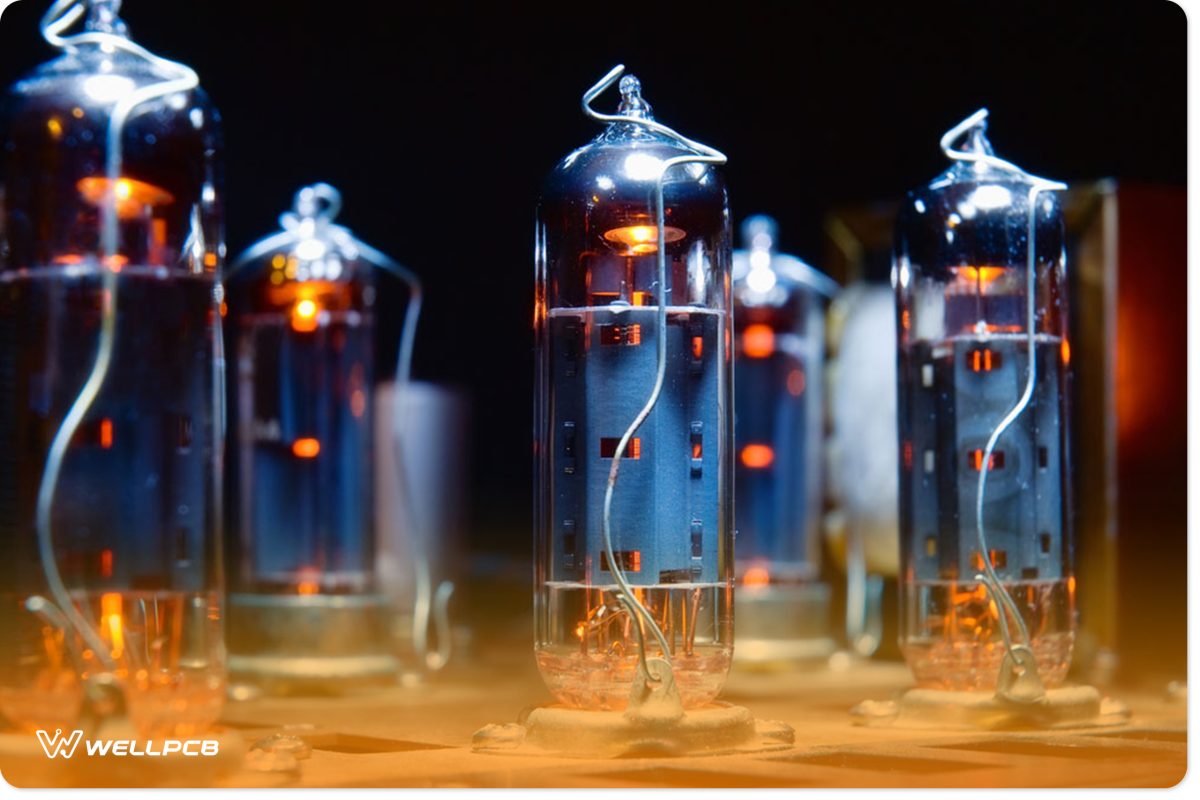Contents
What is a Neon Lamp?
Neon lamps or gas discharge tubes are light sources that use vacuum tube technology. It features two electrodes and neon gas inside a small glass capsule-like vacuum tube. Also, these neon lamps brighten up once the neon gas receives an electric light. Thus giving you the soft neon glow illumination you know and love.

Glowing Neon Bars
Although the glow of a neon lamp (usually the orange color) is not bright enough to light your way in the dark, it works perfectly as an indicator lamp since it emits a faint glow.

Vacuum Tube Technology
How does Neon Lamp Work?
Neon lamps wouldn’t work unless they receive an input voltage higher than the burning voltage. This high starting voltage is responsible for triggering the glow of the neon lamp. Thus, we call this voltage the inceptive breakdown voltage or striking voltage.
Once the neon lamp reaches this breakdown point, the lamp moves into firing mode (glowing mode).
Afterward, it allows the voltage to diminish across the terminals of the neon.
Plus, it remains fixed regardless of any increase to the current you feed into the circuit.
Plus, once the lamp starts to glow, you can increase the intensity or brightness of the emitted light by increasing the supply voltage. It can reach a point where the glow fills the entire part of the negative resistance electrode.
Here’s where you need to be careful.
If you go past the maximum current the lamp can handle, the light enters an arcing state. The glow won’t be orange in this arcing state but a blue-white bulb that fills the negative electrodes. Once this happens, the lamp will start degrading rapidly.
So, if you want to use a neon lamp properly, you’ll need enough current for the lightbulb to glow. You’ll also require a voltage regulator to regulate the level of current the lamp receives. These two combined help keep the neon lamp working around the normal glow discharge state.
Since the normal resistance of the neon in firing mode is low, you’ll need to install “series resistors” to one of the supply lines. So, that’s where the ballast or simple resistor comes into play.
The Breakdown Voltage For A Neon Lamp
Now, the neon lamp’s breakdown voltage or striking voltages are usually between 60 – 100 volts. Sometimes, it could be higher. However, the current needed to run the lamp continuously is smaller—somewhere around 0.1 to 10 milliamps.
For the “series resistor,” you can decide the value according to the input voltage supply you’re attaching your neon to—mains constant voltage source or otherwise.
Here’s a good example.
If you’re attaching your lamp to a 220-volt supply, a 220k resistor value would be a good choice.
In the case of commercial neon lamps, the resistor is usually in-built.
Plus, the neon lightbulb has little or no resistance when emitting light but experiences a voltage drop at 80 volts over the neon terminals.
Simple Neon Bulb Circuits
Now, it’s time to look at the different circuits you can make with the neon bulb.
Note: You can use these neon circuits for various neon lamp applications like indicators, decorative lights, or ambient lights.
Flasher Circuit For Neon Lamp
The first simple circuit uses a neon lamp as a lamp flasher. Also, this works perfectly well for a relaxation oscillator circuit.
Check it out in the diagram below:
This circuit shows a capacitor and resistor joined in levels to a DC supply voltage. Also, we can see the neon lamp attached side by side to the capacitor. Hence, it functions as a visual indicator, and the neon lamp shows how well the circuit functions.
At first glance, the neon bulb would resemble the open circuit. But, once it receives the ignition voltage, it allows current to flow through it instantly. Thus allowing the lamp to glow.
So, once you power up this circuit, the capacitor starts charging at a rate set by the RC time constant. Thus, the neon bulb will receive a supply equal to the capacitor terminals’ charge.
Additionally, once the lamp goes into firing mode, the capacitor starts discharging through the gas in the neon bulb.
Moreover, as soon as the capacitor completes its discharge, it stops the current flow to the lamp. Then, it gathers another charge higher than the lamp’s firing voltages. In other words, you can set the neon lamp to blink or flash according to the values set by the RC constant.
The Tone Generator for Neon Lamp
Here’s another simple neon bulb circuit that works like an electronic oscillator.
Check out the diagram below:
Now, this circuit has the potential to become a generator circuit’s signal. Plus, you can use tiny loudspeakers or even your headphones to listen to the output, and it’s possible only when you adjust the potentiometer’s uneven tone.
But there’s more.
You can design your neon flashers to work randomly (for random flashing). Or better still, work sequentially.
Plus, if you need more stages on this circuit, you can add them easily by connecting the C3 to the final stage.
The Astable Flasher Neon Lamp
This type of Neon lamp comes with an astable multivibrator circuit that features two neon bulbs. Take a look at the circuit diagrams below:
You can set the neon light bulbs to blink in an on/off sequence in this circuit. What’s more, you can choose the frequency of operation at which they blink or flash via R1, R2, and C1. However, the two resistors must have identical values.
But, if you increase the value of the capacitor or the relaxation oscillator circuit’s ballast resistor, it will diminish the flashing frequency of the neon lamps. Also, this works both ways.
Here’s another secret tip for this circuit.
If you want to guard the life of your neon lamp and get the best results from this circuit, you should not choose a ballast resistor with a rating lower than 100k, and you should maintain the value of your capacitor under 1 MFD.
Why Use Neon Lamps as Indicator Lamps
Though most modern circuits use LEDs, we can still find neon lamps that work as pilot lights or AC mains indicators.
- Neon lamps are durable.
- They have a minimal current drain
- Neon lamps have shock and vibration resistance
- Finally, these lamps don’t overheat
What Makes a Neon Lamp Unique?
You can change the color of your neon lamp from orange to other colors by adding little bits of other gases like krypton or argon. Argon lights up a UV light, which you can change into the color you want. How? You see neon signs like the colors by fitting the wall inside your lamp with a fluorescent coating.
In addition to working with a high voltage and low current, you’ll need a voltage slightly higher than the burning voltage to start a neon lamp (maybe around 10 to 20v higher). Thus, the neon lamp does not need special starting circuits since the main supply is high enough for the job.
But that’s not all.
You can’t connect a neon lamp directly to a voltage source without installing a device for limiting current. In this case, a ballast. Luckily, this isn’t a problem, as you can use a simple resistor as a current limiter. However, most models that you can directly plug to mains voltage come with a built-in ballast resistor.
Summing Up
Neon lamps are old, but they are still useful in today’s modern world. We can find them helpful in applications that use a variety of voltages, temperatures, and brightness.
Plus, the neon bulb has different colors and brightness levels for you to choose from, and it’s even suitable for ambient light applications.
The best part is that you can extend a neon lamp’s life by reducing the operating voltage. Thus, applications that can use up to 50,000 hours would use a resistor with a higher current rating value. Therefore, reducing the lamp current and increasing lamp life. Well, that sums up this article. If you have any questions, feel free to contact us, and we’ll be happy to help.





